 Catalog:

Uzbekistan is a country with an ancient history and the culture having more than 25 centuries, with legendary fantastic Samarkand, Bukhara, Khiva cities. Uzbekistan is: - oriental hospitality and goodwill, exotic, abundance of noisy and picturesque markets; - warm stable weather-10 months a year; - hotels, restaurants, night bars with national colour and European level of service; - fine opportunities for active rest in mountains and desert. Alongside with excursion program you will be able to: - visit the dramatized historical ceremonies and folklore shows; - take pleasure with oriental dances in former Khans harem; - learn to prepare original Uzbek pilaw and round bread; - weave carpets; - make a jug in a workshop of the potter; - pass through picturesque desert on baktrian camel back; - ride on graceful akhaltekin horses; - swim and to fish in huge lakes surrounded by sands; - reach inaccessible mountains on helicopter and to lead picnic on mountain river side; - spend the night in traditional nomads abodes – yurtas; - listen to local akyn songs at a fire under extraordinary bright oriental constellations; - visit exotic national-sports and holidays wrestling, horse wrestling for goat’s carcass, rams, cocks fighting; - taste collection wines; - get original hand-made souvenirs. The tours can be organized in your own dates / any number of pax, cost & conditions are available upon request.
Contact us:
your.climberca@ya.ru +7966 065-53-44 - whatsapp/viber
Author: ClimberCA - International consortium
More info >>>
We are online!
|
 Catalog
Catalog /
Bukhara sights
Resources:
49
-
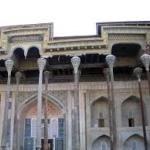 Balyand Mosque
www
Balyand Mosque
www
An excellent example of a quarter ritual center is the Balyand Mosque in the western part of old Bukhara. The mosque belongs to the beginning of the 16-th century. It has a cube-shaped structure with adjoining colonnade. The Balyand Mosque is famous for its refined interior. Especially the paneling made of hexahedral glazed tiles painted with gold, which goes round the hall. The mosque took its name ("balyand" means "lofty") because of raised stone bed, on which rests the construction.
Rating: 321
-
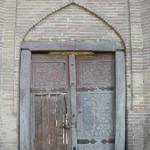 Goziyon Madrasah
www
Goziyon Madrasah
www
The madrasah bears the name of historical residential area - Goziyon ("faith defenders") - one of the most important centers of Muslim education in pre-Soviet Bukhara. Goziyon had several Madrasahs that functioned till Russian Revolution of 1917. The largest of Goziyon - the madrasah of Mullo Mukhammad-Sharif - is lost. It was built in the early 19th century. The intact madrasah Goziyon-i Kalon (Great Goziyon) is one of two madrasahs of former so called "kosh" ensemble, which is typical of Bukhara. The word "kosh" means "paired" because two structures of the ensemble face one another across a street or square. Number two of the pair was Goziyon-i Hurd Madrasah (Small Goziyon).
Rating: 300
-
 Taq-i Telpaq Furushon
www
Taq-i Telpaq Furushon
www
The intersections of main streets of medieval Bukhara served a purpose of trade, that caused a construction there of notable domed structures – taq(s) and tim(s). Passing by Po-i Kalyan northwardly one can reach a place of ancient four bazaars ("Chakhar suk" or "Chorsu"). There is situated the first of such structures, called Chorsu or Taq-i Zargaron ("zargaron" means "jeweler"). Shortly after Tim Abdullakhan the same street leads to southeast where it meets northern passageway of Taq-i Telpaq Furushon (Toki Telpak Furushon Trading Dome). Besides this street four more streets at different angles reach the structure. Architects met a challenge by making passageways for each street between six radially placed pylons carrying a low cylindrical cupola (of 14.5 meters in diameter) with dodecahedral skylight. The galleries with niches and storerooms around the central hall are located on twelve inner 12 axes. Taq-i Telpaq Furushon was a shopping mall mainly of fur and other kind of head-dresses such as skullcaps embroidered with gold-thread and beads, fur-hats, and skillfully rolled turbans.
Rating: 266
-
 The Kukeldash Madrasah (1568/69)
www
The Kukeldash Madrasah (1568/69)
www
The word "kukeldash" literally means "foster-brother". In a hierarchy of power inherited from Genghis-khan this word designates one of the most important positions of khans' court. The sponsor of Kukeldash Madrasah was highly influential emir Kulbaba, who held a post of Kukeldash under several khans of the Shaibanid dynasty. It is historically proven, that emir Kulbaba Kukeldash gave help to Abdulla-khan II (1561-1598) - the most powerful khan of the Shaibanid dynasty - to come to power. According to the hallowed tradition of consecration of the khan inherited from Mongols - in the states that appeared after disintegration of the empire - each new khan ought to be lifted lying on the sheet of white felt. The power to strain the sheet from four corners had four men recognized as most influential figure in a commonwealth. Emir Kulbaba was one of four men who consecrated Abdulla-khan II. The title "khan" could be given only to "tore" - agnate lineal descendant of Genghis-khan.
Rating: 249
-
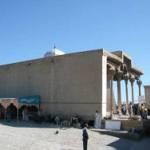 Grand mosque of the Ark
www
Grand mosque of the Ark
www
Inside the fortress leads the ascensional passage ("dalon"). Along the sides of the passage, the rooms for water and sand and prison cells are situated; twelve niches at the left and thirteen at the right of passage. Atop, opposite the passage dominates the gallery of the Grand mosque. It has a lay-out of big quarter mosque with one prayer room, framed with the portico on wooden pillars – a gallery (eivan/ iwan/ ivan,ivvan) over its three sides. The period of the Bukhara emirate under the government of emir Shahmurad (1785 - 1800) was the time of relative stability and prosperity. Emir Shahmurad nicknamed "sinless emir" carried out repairs of many of old structures in the Ark and built up new ones. Therefore, in all probability, the earlier building of Grand mosque on that place was rebuilt and reshaped during the government of emir Shahmurad. The building of Grand mosque has the signs of later reconstructions (made, admittedly, at the close of the 19-th century).
Rating: 246
-
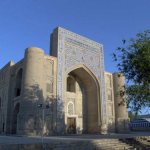 The Lyabi Khauz Ensemble
www
The Lyabi Khauz Ensemble
www
The Labi Khauz, i.e. "at the pond", is the title given to the area surrounding one of the few remaining Hauz or ponds surviving in the city of Bukhara. Until the Soviet period there were many such ponds, which were the city's principal source of water, but they were notorious for spreading disease and were mostly filled in during the 1920s and 30s. The Lyab-i Hauz survived because it is the centrepiece of a magnificent architectural ensemble, created during the 16th and 17th centuries, which has not been significantly changed since. The ensemble comprises three monumental structures: Kukeldash Madrasah in the north, Khanaka (1619-20) in the west and Nadir divan-begi Madrasah (1622/23) (on Bukhara map Nodir Devan-Begi Madrasah) in the east. The small Qazi-e Kalyan Nasreddin madrasah (now demolished) was formerly located beside the Kukeldash Madrasah.
Rating: 246
-
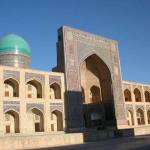 The Mir-i-Arab Madrasah (1535-1536)
www
The Mir-i-Arab Madrasah (1535-1536)
www
The construction of Mir-i-Arab Madrasah ( Miri Arab Madrasah) is ascribed to Sheikh Abdullah Yamani of Yemen - called Mir-i-Arab - the spiritual mentor of Ubaidullah-khan and his son Abdul-Aziz-khan. Ubaidullah-khan waged permanent successful war with Iran. At least three times his troops seized Herat. Each of such plundering raids on Iran was accompanied by capture of great many captives. They say that Ubaidullah-khan had invested money gained from redemption of more than three thousand Persian captives into construction of Mir-i-Arab Madrasah.
Rating: 243
-
 The Khanaka of Nadir Divan-begi (1619/20)
www
The Khanaka of Nadir Divan-begi (1619/20)
www
This Khanaka a rectangular edifice topped with a dome. The building has non-traditional narrow and prolate main portal along with two lateral entrances. The hall (dhikr-hana) has excellent acoustic properties. The inner walls of the hall are recessed with niches fringed with stucco moldings. The dwelling space occupies corners and lateral exterior walls of the building. The finishing of the main entrance gate is made quite conservatively, with an exception of some floral elements in ornamentation. The edges of the main portal are overworked with epigraphy ornaments. The main front of the khanaka is cornered with towers cut at a level of the walls.
Rating: 241
-
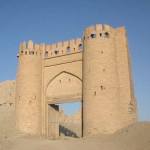 The fortified walls and gates in Bukhara
www
The fortified walls and gates in Bukhara
www
The real subjects of curiosity in Bukhara are fortified walls and gates. The section of the city wall with huge breaches in the brickwork is the good sample of fortification architecture. It is also an important element in the topography of the city, one that is closely associated with the history of Bukhara.
Rating: 240
-
 Mullo Tursunjon Madrasah
www
Mullo Tursunjon Madrasah
www
At the third decade of the 16-th century Bukhara became a capital of Bukhara khanate, under the government of Shaibanid dynasty. The whole period when this dynasty was in power is about one century since the beginning of the 16-th century. Shaibanids carried out many reforms during this time. In particular they instituted a number of measures to better system of the public education. Each residential quarter (neighborhood and unit of local self-government also "mahalla") of Bukhara had a hedge-school. Prosperous families provided home education to their children. Children started elementary education from six years. After two years they could be taken to a madrasah.
Rating: 237
-
 Khanaka of Khalifa Khudoydod
www
Khanaka of Khalifa Khudoydod
www
The Khalifa Khudoydod (locally Xalifa Xudoydod) Khanaka, ascribed to Khalifa Khudoydod (an eminent eshon - probably he bore the title Caliph - buried on the neighboring ancient cemetery - Eshoni Imlo), belongs to historical monuments of XVIII century. According to narrative, Khalifa Khudoydod lived more than 200 years ago and came to Bukhara from Urgench. Arguably Khalifa Khudoydod and sheikh Khudoyberdi, whose written biography is known as "Lutfiy Busurg", is the same person ("Khudoyberdi" in Turkic languages is a loan translation from "Khudoydod" in Persian).
Rating: 232
-
 Gaukushon Complex
www
Gaukushon Complex
www
One of the major ensembles in the center Bukhara is Khoja-Gaukushan (Gaukushon Complex). The madrasah was built in 1570 by order of Abdullah-khan II (1561-1598). He came to power with the help of Khoja Islam Juibariy - the powerful leader of local clan of Khoja(s). This clan - often identified as "Juibariya". Abdullah-khan was a disciple (murid) of Khoja Islam, therefore he always gave support to the clan. He built many religious and civil installations for them.
Rating: 232
-
 Ghujdawan
www
Ghujdawan
www
Ghujdawan - a district administrative centre along the road to Samarkand - is famous first of all as a native place of Abdul Khaliq al-Ghujdawani, the founder of Sufi order (tarica) called Khwajaganiyya the predecessor of Naqshbandiyya. Together with Ahmad Yasavi young Abdul Khaliq Ghujdawani was one of four successors of Yusuf ibn al-Husayn al-Hamadani (the prominent Sufi master of his time). Al-Ghujdawani has died in about 1220 when he was 95. In 1433, to the west of al-Ghujdawani's mazar, by order of Ulugh Beg, was built the latest of three his madrasahs.
Rating: 230
-
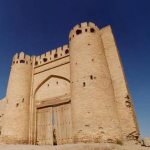 Talipach gate
www
Talipach gate
www
Researchers identified the names of eleven of city gates (five of which were in the extant area of the wall). Only two of them are intact now: Talipach gate in the north and Karakul gate in the south-west. The date of their building is the end of the 16th century. The Sheikh Djalal gate in the south recently went to ruin.
Rating: 228
-
 The Khanaka of Kosim-sheikh
www
The Khanaka of Kosim-sheikh
www
Kosim-sheikh was an acknowledged religious leader during the reign of Abdullah-khan II (1561-1598), the most successful khan of Shaibanid dynasty. His body was laid to rest in Kermine (at present time Nawoiy). However one of urban quarters in Bukhara formerly bore the name of Kosim-sheikh. There also is a mazar, known as the holy grave of Kosim-sheikh. Near to the mazar there is a well. People consider that water from this well is curative, believing that Kosim-sheikh miraculously made the well. In Kermine there is a big khanaka-mosque (XVI), called the Khanaka of Kosim-sheikh.
Rating: 226
-
 The Sitora-I-Mohi-Hosa Palace
www
The Sitora-I-Mohi-Hosa Palace
www
The summer-palace of Bukhara emir Sitora-I-Mohi-Hosa (Sitora-i-Mohi-Khosa) (from Persian "House of the Moon and the Star") is located at a distance of 4 kilometers (2,5 miles) to the north from Bukhara. The construction of the palace had began at the end of the 19-th century, when the best artisans sent by the order of the Bukhara emir Ahadhan to St. Petersburg and Yalta for studying of experience of Russian architects had returned from Russia. Therefore, architecture of the ensemble is a mix of the elements typical for European architecture with ornate interior design of Isfahan palaces and the centuries-old experience of local construction traditions.
Rating: 225
-
 The Kosh Madrasah Ensemble
www
The Kosh Madrasah Ensemble
www
In the same district with the Samanid mausoleum and Chashma-iy-Ayub, not far from the park is situated one of the most interesting ensembles of Bukhara "Kosh-Madrasah" (Kosh Madrasah Ensemble), which is typical of Bukhara. The word "Kosh" means "paired" because two structures of the ensemble face one another across a narrow street.
The sponsor of the Ensemble was Abdullah-khan II (1561-1598), the most successful khan of Shaibanid dynasty. In 974 A.H. (1566-67) he built up the Modari-khan Madrasah in memory of his mother (“Modari-khan” means “mother of khan”). The date of construction is inserted in majolica inscription above the main entrance. As to composition of structure, the madrasah has fairly standard layout including a dormitory, which consists of small cells (hudjras) around a courtyard, public halls of a mosque and lecture-rooms (darskhana) along both sides of front. The facade (peshtaq) of the madrasah has gorgeous appearance because of multicolor brick mosaic.
Rating: 223
-
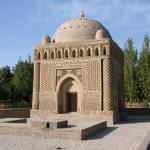 Samanid Mausoleum
www
Samanid Mausoleum
www
The Samanid mausoleum is located in the historical urban nucleus of the city of Bukhara, in a park laid out on the site of an ancient cemetery. The mausoleum, one of the most esteemed sights of Central Asian architecture, was erected by the Samanid ruler Ismail Samani sometime before 943 AD. An existing waqf document indicates that it was possibly built for his father. Although three bodies lie within, a wooden plaque identifies only Ismail's grandson, Nasr ibn Ahmad ibn Ismail or as-Said Nasr II (d. 943). Ostensibly the family crypt of the last Persian dynasty to rule in Central Asia, which held the city in the 9th and 10th centuries, it is possible that, consistent with popular nomenclature, the structure does indeed contain the grave of Ismail Samani himself.
Rating: 222
-
 The Namazgoh Mosque
www
The Namazgoh Mosque
www
Namazgoh (Namazgokh Mosque) is one of the oldest constructions of Bukhara in the South of present-day city. The first known Namazgoh at this place was developed in the 9-th century, during the reign of the Samanid dynasty. One of the characters of this time is stabilization of the power under Islam ideology. Because of it, Bukhara became one of the major Islamic centers on the East. It was the time of general construction of ritual buildings (mosques, namazgohs), educational institutions (madrasahs) and other structures peculiar to usages of new religion such as khanaka, minaret and so on.
Rating: 219
-
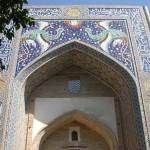 The Nadir Divan-Begi Madrasah (1622/23)
www
The Nadir Divan-Begi Madrasah (1622/23)
www
Originally Nadir Divan-begi intended the building to be a caravanserai (not that it was allowed to portray human or animal figures on them either but it was marginally better than on a madrasah). But at the inauguration ceremony, Imam Quli-khan unexpectedly proclaimed the supposed caravanserai is to be a madrasah. So Nadir Divan-begi was obliged to rearrange the caravanserai, by adding on to the front the loggias and angular towers. He also constructed an additional storey with cells (hujras). At the same time the madrasah does not have a lecture room! The entrance portal has depictions of 2 phoenix birds, 2 misshapen white deer and a "man-in-the-sun" face.
Rating: 219
|







 Balyand Mosque
Balyand Mosque  Goziyon Madrasah
Goziyon Madrasah  Taq-i Telpaq Furushon
Taq-i Telpaq Furushon  The Kukeldash Madrasah (1568/69)
The Kukeldash Madrasah (1568/69)  Grand mosque of the Ark
Grand mosque of the Ark  The Lyabi Khauz Ensemble
The Lyabi Khauz Ensemble  The Mir-i-Arab Madrasah (1535-1536)
The Mir-i-Arab Madrasah (1535-1536)  The Khanaka of Nadir Divan-begi (1619/20)
The Khanaka of Nadir Divan-begi (1619/20)  The fortified walls and gates in Bukhara
The fortified walls and gates in Bukhara  Mullo Tursunjon Madrasah
Mullo Tursunjon Madrasah  Khanaka of Khalifa Khudoydod
Khanaka of Khalifa Khudoydod  Gaukushon Complex
Gaukushon Complex  Ghujdawan
Ghujdawan  Talipach gate
Talipach gate  The Khanaka of Kosim-sheikh
The Khanaka of Kosim-sheikh  The Sitora-I-Mohi-Hosa Palace
The Sitora-I-Mohi-Hosa Palace  The Kosh Madrasah Ensemble
The Kosh Madrasah Ensemble  Samanid Mausoleum
Samanid Mausoleum  The Namazgoh Mosque
The Namazgoh Mosque  The Nadir Divan-Begi Madrasah (1622/23)
The Nadir Divan-Begi Madrasah (1622/23) 